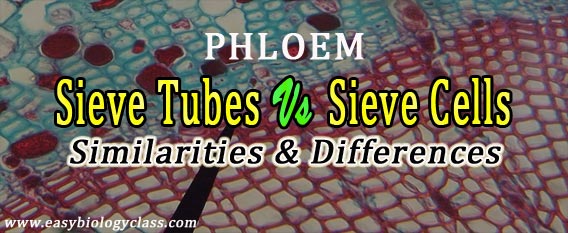Phloem is a permanent vascular tissue system associated with the conduction of food materials in plants. It is a complex tissue composed of more than one type of cells namely sieve elements, companion cells, phloem fibres and phloem parenchyma. Among these cells, the sieve elements are the most specialized cells in the phloem performing the conduction of food materials. The present post describes the similarities and difference between sieve cells and sieve tubes with a comparison table.
There are two types of sieve elements are described among vascular plants based on structural complexity and evolutionary significance. They are (1) Sieve Cells and (2) Sieve Tubes.

Similarities between Sieve Cells and Sieve Tubes
Ø Both sieve cells and sieve tubes components of phloem.
Ø Both are the sieve elements (a category of phloem cells).
Ø Both sieve cells and sieve tubes transport food materials.
Ø Both are living cells.
Ø Both cells have thin primary cell wall (secondary thickening absent).
Ø Both contain dense granular protoplasm.
Ø Nucleus is absent in both sieve cells and sieve tubes.
Ø Both present in primary and secondary phloem.
Difference between Sieve cells and Sieve Tubes
Sl. No. Sieve Cells Sieve Tubes
1 Sieve cells are present in the phloem of lower plants such as Pteridophytes and Gymnosperms Sieve tubes are present in the phloem of Angiosperms*
2 Sieve cells are single cells Sieve tubes are syncytes (aggregation of cells), placed vertically one above the other forming long tubes.
3 Sieve cells are less specialized sieve elements of phloem. Sieve tubes are much specialized sieve elements of phloem.
4 Sieve cells are long and narrow cells with tapering end walls. Sieve tubes are comparatively shorter and wider cells with transverse or oblique end walls
5 The sieve area in the sieve cells are simple and primitive type without any structural advancements. The sieve area in sieve tubes is complex and advanced.
6 The sieve area does not have sieve plates. The sieve area is restricted to the sieve plates.
7 Sieve pores are scattered all along the wall or even at the end wall. Sieve pores are located on the sieve plates. Sieve plates are restricted at the cross wall which may be transverse or oblique.
8 Companion cells absent Companion cells present
9 Sieve cells are accompanied with less specialized Albuminous cells (or Strasburger cells). Sieve tubes are accompanied with more specialized companion cells, Albuminous cells absent.
10 Sieve cells and albuminous cells are ontogenetically different (non-sister cells, have separate origin). Sieve tubes and companion cells are ontogenetically related (sister cells, have a same origin).
*Sieve tubes are reported to present in few Pteridophytes such as Selaginella and Pteridium; and also in some Gymnosperms such as Gnetum and Ephedra.
| You may also like... | ||
|---|---|---|
| NOTES | QUESTION BANK | COMPETITIVE EXAMS. |
| PPTs | UNIVERSITY EXAMS | DIFFERENCE BETWEEN.. |
| MCQs | PLUS ONE BIOLOGY | NEWS & JOBS |
| MOCK TESTS | PLUS TWO BIOLOGY | PRACTICAL |
